Security Control for a Fuzzy System under Dynamic Protocols and Cyber-Attacks with Engineering Applications
Abstract
:1. Introduction
- Asynchronous control for MJ-IT2 fuzzy SPSs—We explore asynchrony for IT2 fuzzy MJ SPSs vulnerable to deception attacks and offer robustness to traditional controllers by addressing the nonlinearity and uncertainties of these systems.
- Unified framework for random attacks—We integrate actuator and random attacks through the use of two independent Bernoulli-distributed random variables, facilitating a security control capable of mitigating the unpredictability of cyber-threats.
- Asynchronous controller design with nonstationary mode transitions: We formulate an asynchronous controller for MJ SPSs, which is capable of handling nonstationary-mode transitions, addressing random deception attacks and setting new security benchmarks for networked control systems.
2. Fundamentals of Singularly Perturbed Systems and Fuzzy Control Integration
2.1. Mathematical Representation of SPSs
2.2. Challenges in SPS Analysis and Control
- A parasitic parameter () that takes small values—Note that induces instability and sensitivity to perturbations, necessitating numerical methods for accurate control [41].
- Higher-order dynamics—The interaction between fast and slow dynamics creates complex behaviors, requiring advanced mathematical techniques for effective analysis [42].
- System stiffness—High sensitivity to input variations impacts stability and performance, demanding robust and adaptive control strategies [43].
2.3. Type-1 and Type-2 Fuzzy Models
- Type-1 fuzzy models: They use precise membership functions within a range from zero to one. A type-1 fuzzy set for an element u is defined as , where denotes the membership function assigning the degree of membership of u in the fuzzy set , and represents the universal set [44].
- Type-2 fuzzy models: They incorporate uncertainty into membership functions, making them effective for ambiguous data. A type-2 fuzzy set is presented aswhere is the membership function for u at a specific uncertainty level , and is the interval of membership grades available for u [45].
2.4. Discussion on Control Characteristics
3. System Description and Preliminaries
3.1. Overview of Markov Jump Systems
3.2. Takagi-Sugeno Fuzzy Model
3.3. Integration of Markov Jumps into TS Fuzzy Models
3.4. Model Specification
- Adaptability—The model dynamically responds to transitions in operational mode , adapting to the MJs that dictate these transitions, whose adaptability ensures that the control strategy remains effective under varying system conditions.
- Precision—The distinction between fast and slow dynamics allows for precise control, which enhances the model ability to optimize systems with multi-time-scale dynamics, improving response times and system behavior.
- Integration of uncertainties—Incorporating IT2 fuzzy sets improves the model capability to integrate uncertainties, whose integration is valuable in environments where input data and system parameters are subject to variability and imprecision.
3.5. Fuzzy Inference and Firing Strength in the Global Fuzzy Model
- Step 1.
- Evaluate the membership functions for each input variable.
- Step 2.
- Calculate the firing strength for each rule by multiplying the membership values.
- Step 3.
- Normalize the firing strengths to ensure they sum to one.
- Step 4.
- Compute the output by weighting each rule output by its normalized firing strength.
3.6. Component-Based Dynamic Event-Triggered Mechanism
3.7. Security Challenges: Sensor and Actuator Attacks
- Implementation of advanced encryption methods for data in transit.
- Utilization of anomaly detection algorithms to identify and isolate falsified data.
- Employment of redundancy and diversified sensor setups to validate data integrity.
- is a diagonal matrix with entries , stating random variables which are Bernoulli-distributed, modeling the sporadic nature of cyber-attacks on actuators.
- models the true malicious payload, which is a nonlinear function designed to disrupt the actuator normal operation, whose function adheres to the safety constraint presented as , ensuring that the potential impact of the attack does not exceed a predefined safety threshold stated by and the matrix H, where is a Markov chain.
- The attack is modeled to adjust dynamically to the system state via the random variable , which, as mentioned, blends the true control signal with the malicious signal, creating a corrupted output that can vary in intensity and effect.
- The employment of sophisticated monitoring systems that can detect unusual behaviors or deviations in actuator performance.
- The design of systems with redundant actuator configurations and fault-tolerant controls that may maintain operation even when some components are compromised.
- The strengthening of cyber-security practices, including regular updates, patches, and protective measures against malware and other forms of cyber-attacks.
3.8. Fuzzy Controller
3.9. Closed-Loop System
- represents estimated error dynamics.
- models disturbances or potential attacks targeting sensors.
- pertains to disruptions or malfunctions in actuators, previously mentioned.
- includes AIDVs, enhancing our model ability to capture complex internal dynamics.
4. Main Results
4.1. Implementing Robust Control Mechanisms
- Developing controllers that efficiently manage uncertainties and dynamically adapt to environmental changes, ensuring operational resilience.
- Mitigating impacts from external disturbances, including sensor and actuator attacks, so preserving the integrity and security of the system.
- Achieving comprehensive system stability, particularly stochastic mean-square stability, crucial for system reliability over prolonged operational periods.
4.2. Controller Design
- (i)
- Scalars , , and , ensuring responsiveness and stability in the controller operation.
- (ii)
- Matrices , , , and scalars , , , , , exist satisfying the stability conditions for each , expressed as , , and , for .
- (i)
- In the controller design described in Theorem 2, the structure of the matrix plays a crucial role in achieving the desired stability properties. Specifically, if , the top-right element of becomes zero. This particular specification is common in the literature and is known to yield conservative results in stability analysis. The matrix is defined aswhere I represents an appropriately dimensioned identity matrix, ensuring compatibility across the matrix dimensions. This matrix allows for flexibility in adjusting the controller gains by modifying the constants and . Adjusting these constants can enhance the system performance by optimizing the response of the controller to changes in system states and disturbances. Therefore, careful selection of and is recommended to tailor the controller performance to specific operational requirements, thereby potentially overcoming the conservatism associated with standard configurations.
- (ii)
- Theorem 2 provides a direct correlation between the expansion of fuzzy rules and MJ modes as well as the subsequent expansion in computing complexity. In this article, the linear matrix inequalities (LMIs) matrices are used to calculate the controller gains, in which the corresponding algorithm dealing with the LMIs has polynomial time complexity. Fortunately, with the increasing power of computers and accelerating advances in LMI optimization techniques, the complex LMIs are well solved.
5. Empirical Applications
5.1. Application I: Control of a Tunnel Diode Circuit
- Case I.
- Next, we explore the strategic development of the CB-DETM controller, designed to protect the system from sensor and actuator deception attacks. This case demonstrates the practical application of IT2 fuzzy models and the MJ framework, highlighting the challenges and implications of applying our methodology in real-world scenarios. Furthermore, this case bridges the gap between theoretical foundations and practical applications, underscoring the relevance of our research in addressing contemporary cyber-security challenges in control systems.
- Case II.
- Now, we explore the feasibility of constructing a dynamic event trigger (DET)-based control system for components with identical triggering parameters, as discussed in Remark 1 and outlined in [52]. We analyze two distinct scenarios characterized by the minimum and maximum values of the parameters. The outcomes of this investigation are succinctly summarized in Table 2. The DET-based control system effectively maintains communication efficiency and control gains by applying uniform triggering parameters. The data, particularly from the comparison with the protocol, show that sensor 1 could remain inactive for up to 28 sample periods. This inactivity indicates the ability of our methodology to reduce redundant communications without affecting system performance. The results from Case II highlight the benefits of uniform triggering parameters in a DET-based control system, pointing to opportunities for enhancing the management of communications within cyber-physical systems, aiming for greater efficiency and optimization.
- Case III.
- In this case, we evaluate the resilience of the proposed methodology by increasing the intensity of cyber-attacks. The actuator attack intensity is increased by a factor of 15, and the sensor by a factor of 20. Figure 7 illustrates the system state trajectories under these intensified attacks, demonstrating that stability is maintained despite the escalated threat level.
5.2. Discussion and Limitations
5.3. Controller Performance Results
5.4. Application II: Another Operational Context
6. Conclusions and Future Work
- Robust framework integration—It effectively handled uncertainties and dynamic changes, critical for managing stochastic cyber-attacks.
- Enhanced communication efficiency—It optimized data transmission, reducing unnecessary communications while maintaining stability.
- Resilience under cyber-attacks—It maintained system stability under intense attacks.
- Comparative superiority: It demonstrated enhanced stability and robustness compared to existing methods.
- Adaptive control mechanisms—It dynamically adjusted control parameters in response to real-time conditions, ensuring resilience and operational integrity.
Author Contributions
Funding
Data Availability Statement
Acknowledgments
Conflicts of Interest
References
- Mei, X.; Rodríguez, J.; Kennel, R. Advanced control strategies of induction machine: Field oriented control, direct torque control and model predictive control. Energies 2018, 11, 120. [Google Scholar] [CrossRef]
- Yan, Y.; Yang, C.; Ma, X.; Zhou, L. Observer-based event-triggered control for singularly perturbed systems with saturating actuator. Int. J. Robust Nonlinear Control 2019, 29, 3954–3970. [Google Scholar] [CrossRef]
- Yang, C.; Li, F.; Kong, Q.; Chen, X.; Wang, J. Asynchronous fault-tolerant control for stochastic jumping singularly perturbed systems: An H∞ sliding mode control scheme. Appl. Math. Comput. 2021, 389, 125562. [Google Scholar] [CrossRef]
- Efheij, H.; Albagul, A.; Albraiki, N.A. Comparison of model predictive control and PID controller in real time process control system. In Proceedings of the 2019 19th International Conference on Sciences and Techniques of Automatic Control and Computer Engineering (STA), Sousse, Tunisia, 24–26 March 2019; pp. 64–69. [Google Scholar]
- Cheng, J.; Park, J.H.; Zhao, X.; Karimi, H.R.; Cao, J. Quantized nonstationary filtering of networked Markov switching RSNSS: A multiple hierarchical structure strategy. IEEE Trans. Autom. Control 2020, 65, 4816–4823. [Google Scholar] [CrossRef]
- Wan, X.; Wang, Z.; Wu, M.; Liu, X. H∞ State estimation for discrete-time nonlinear singularly perturbed complex networks under the round-robin protocol. IEEE Trans. Neural Netw. Learn. Syst. 2019, 30, 415–426. [Google Scholar] [CrossRef]
- Zheng, D.D.; Guo, K.; Pan, Y.; Yu, H. Indirect adaptive control of multi-input-multi-output nonlinear singularly perturbed systems with model uncertainties. Neurocomputing 2022, 491, 104–116. [Google Scholar] [CrossRef]
- Wang, J.; Yang, C.; Xia, J.; Wu, Z.G.; Shen, H. Observer-based sliding mode control for networked fuzzy singularly perturbed systems under weighted try-once-discard protocol. IEEE Trans. Fuzzy Syst. 2022, 30, 1889–1899. [Google Scholar] [CrossRef]
- Cheng, J.; Wang, Y.; Park, J.H.; Cao, J.; Shi, K. Static output feedback quantized control for fuzzy Markovian Switching Singularly Perturbed Systems with Deception Attacks. IEEE Trans. Fuzzy Syst. 2022, 30, 1036–1047. [Google Scholar] [CrossRef]
- Charfeddine, S.; Boudjemline, A.; Ben Aoun, S.; Jerbi, H.; Kchaou, M.; Alshammari, O.; Elleuch, Z.; Abbassi, R. Design of a fuzzy optimization control structure for nonlinear systems: A disturbance-rejection method. Appl. Sci. 2021, 11, 2612. [Google Scholar] [CrossRef]
- Alshammari, O.; Kchaou, M.; Jerbi, H.; Ben Aoun, S.; Leiva, V. A fuzzy design for a sliding mode observer-based control scheme of Takagi-Sugeno Markov jump systems under imperfect premise matching with bio-economic and industrial applications. Mathematics 2022, 10, 3309. [Google Scholar] [CrossRef]
- Chaouch, H.; Charfeddine, S.; Ben Aoun, S.; Jerbi, H.; Leiva, V. Multiscale monitoring using machine learning methods: New methodology and an industrial application to a photovoltaic system. Mathematics 2022, 10, 890. [Google Scholar] [CrossRef]
- Kuppusamy, V.; Shanmugasundaram, M.; Dhandapani, P.; Martin-Barreiro, C.; Cabezas, X.; Leiva, V.; Castro, C. Addressing a decision problem through a bipolar Pythagorean fuzzy approach: A novel methodology with application in digital marketing. Heliyon 2024, 10, e23991. [Google Scholar] [CrossRef]
- Dhandapani, P.; Thippan, J.; Martin-Barreiro, C.; Leiva, V.; Chesneau, C. Numerical solutions of a differential system considering a pure hybrid fuzzy neutral delay theory. Electronics 2022, 11, 1478. [Google Scholar] [CrossRef]
- Carreon-Ortiz, H.; Valdez, F.; Castillo, O. Comparative study of type-1 and interval type-2 fuzzy logic systems in parameter adaptation for the fuzzy discrete mycorrhiza optimization algorithm. Mathematics 2023, 11, 2501. [Google Scholar] [CrossRef]
- Salem, F.; Mosaad, M.I. A comparison between MPC and optimal PID controllers: Case studies. In Proceedings of the Michael Faraday IET International Summit 2015, Kolkata, India, 12–13 September 2015; pp. 59–65. [Google Scholar]
- Hu, Y.; Cai, C.; Lee, S.; Lee, Y.; Kwon, O.M. New results on H∞ control for interval type-2 fuzzy singularly perturbed systems with fading channel: The weighted try-once-discard protocol case. Appl. Math. Comput. 2023, 448, 127939. [Google Scholar] [CrossRef]
- Yang, Y.; Niu, Y.; Reza Karimi, H. Dynamic learning control design for interval type-2 fuzzy singularly perturbed systems: A component-based event-triggering protocol. Int. J. Robust Nonlinear Control 2022, 32, 2518–2535. [Google Scholar] [CrossRef]
- Wang, J.; Liu, X.; Xia, J.; Shen, H.; Park, J.H. Quantized interval type-2 fuzzy control for persistent dwell-time switched nonlinear systems with singular perturbations. IEEE Trans. Cybern. 2022, 52, 6638–6648. [Google Scholar] [CrossRef] [PubMed]
- Liu, S.; Cheng, J.; Zhang, D.; Yan, H.; Park, J.H. Saturation control for fuzzy Markovian switching systems with singularly perturbation and cyber-attacks. Inf. Sci. 2022, 609, 931–948. [Google Scholar] [CrossRef]
- Li, F.; Xu, S.; Zhang, B. Resilient asynchronous H∞ control for discrete-time Markov jump singularly perturbed systems based on hidden markov model. IEEE Trans. Syst. Man Cybern. Syst. 2020, 50, 2860–2869. [Google Scholar] [CrossRef]
- Kchaou, M.; Jerbi, H.; Toual, B.; Kouzou, A. Non-fragile mixed H∞/passive-based asynchronous sliding mode control for nonlinear singular Markovian jump systems. Int. J. Syst. Sci. 2022, 53, 447–467. [Google Scholar] [CrossRef]
- Hamidi, F.; Jerbi, H.; Alharbi, H.; Leiva, V.; Popescu, D.; Rajhi, W. Metaheuristic solution for stability analysis of nonlinear systems using an intelligent algorithm with potential applications. Fractal Fract. 2023, 7, 78. [Google Scholar] [CrossRef]
- Cheng, J.; Zhan, Y. Nonstationary l2 − l∞ filtering for Markov switching repeated scalar nonlinear systems with randomly occurring nonlinearities. Appl. Math. Comput. 2020, 365, 124714. [Google Scholar] [CrossRef]
- Zhang, H.; Chen, H.; Xiong, L.; Zhang, Y. Dynamic event-triggered control for delayed nonlinear Markov jump systems under randomly occurring dos attack and packet loss. Mathematics 2024, 12, 1064. [Google Scholar] [CrossRef]
- Latrach, C.; Kchaou, M.; Rabhi, A.; El Hajjaji, A. Decentralized networked control system design using Takagi-Sugeno (TS) fuzzy approach. Int. J. Autom. Comput. 2015, 12, 125–133. [Google Scholar] [CrossRef]
- Chu, X.; Li, M. Observer-based model following sliding mode tracking control of discrete-time linear networked systems with two-channel event-triggered schemes and quantizations. Appl. Math. Comput. 2019, 355, 428–448. [Google Scholar] [CrossRef]
- Kchaou, M.; Regaieg, M.A. Event-triggered extended dissipativity fuzzy filter design for nonlinear Markovian switching systems against deception attacks. Mathematics 2023, 11, 2064. [Google Scholar] [CrossRef]
- Ahmad, I.; Ge, X.; Han, Q.L. Decentralized dynamic event-triggered communication and active suspension control of in-wheel motor driven electric vehicles with dynamic damping. IEEE/CAA J. Autom. Sin. 2021, 8, 971–986. [Google Scholar] [CrossRef]
- Chu, X.; Li, M. H∞ non-fragile observer-based dynamic event-triggered sliding mode control for nonlinear networked systems with sensor saturation and dead-zone input. ISA Trans. 2019, 94, 93–107. [Google Scholar] [CrossRef]
- Chen, Q.X.; Chang, X.H. Resilient filter of nonlinear network systems with dynamic event-triggered mechanism and hybrid cyber-attack. Appl. Math. Comput. 2022, 434, 127419. [Google Scholar] [CrossRef]
- Zhao, N.; Shi, P.; Xing, W.; Lim, C.P. Event-triggered control for networked systems under denial of service attacks and applications. IEEE Trans. Circuits Syst. I Regul. Pap. 2022, 69, 811–820. [Google Scholar] [CrossRef]
- Zhang, H.; Hu, J.; Liu, G.P.; Yu, X. Event-triggered secure control of discrete systems under cyber-attacks using an observer-based sliding mode strategy. Inf. Sci. 2022, 587, 587–606. [Google Scholar] [CrossRef]
- Kaviarasan, B.; Kwon, O.M.; Park, M.J.; Sakthivel, R. Reduced-order filtering for semi-Markovian jump systems against randomly occurring false data injection attacks. Appl. Math. Comput. 2023, 444, 127832. [Google Scholar] [CrossRef]
- Liu, J.; Yin, T.; Cao, J.; Yue, D.; Karimi, H.R. Security control for T-S fuzzy systems with adaptive event-triggered mechanism and multiple cyber-attacks. IEEE Trans. Syst. Man Cybern. Syst. 2021, 51, 6544–6554. [Google Scholar] [CrossRef]
- Charfeddine, S.; Alharbi, H.; Jerbi, H.; Kchaou, M.; Abbassi, R.; Leiva, V. A stochastic optimization algorithm to enhance controllers of photovoltaic systems. Mathematics 2022, 10, 2128. [Google Scholar] [CrossRef]
- Aykroyd, R.; Leiva, V.; Ruggeri, F. Recent developments of control charts, identification of big data sources and future trends of current research. Technol. Forecast. Soc. Change 2019, 144, 221–232. [Google Scholar] [CrossRef]
- Palanivelu, K.; Leiva, V.; Dhandapani, P.B.; Castro, C. On fuzzy and crisp solutions of a novel fractional pandemic model. Fractal Fract. 2023, 7, 528. [Google Scholar] [CrossRef]
- Ma, Z.; Song, J.; Zhou, J. Reliable event-based dissipative filter design for discrete-time system with dynamic quantization and sensor fault. Appl. Math. Comput. 2022, 418, 126823. [Google Scholar] [CrossRef]
- Kokotovic, P.V.; Khalil, H.K.; O’Reilly, J. Singular Perturbation Methods in Control: Analysis and Design; SIAM: Philadelphia, PA, USA, 1999. [Google Scholar]
- Kokotovic, P.V.; Sannuti, P. Applications of singular perturbation techniques to control problems. SIAM Rev. 1984, 26, 501–550. [Google Scholar] [CrossRef]
- Haddad, W.M.; Chellaboina, V.; Nersesov, S.G. Impulsive and Hybrid Dynamical Systems: Stability, Dissipativity, and Control; Princeton University Press: Princeton, NJ, USA, 2011. [Google Scholar]
- Cao, Y.; Chen, Y.; Patton, R.J. Control of stochastic hybrid systems with application to power regulation in wind energy conversion systems. IEEE Trans. Control Syst. Technol. 2002, 10, 685–694. [Google Scholar]
- Zadeh, L.A. Fuzzy sets. Inf. Control 1965, 8, 338–353. [Google Scholar] [CrossRef]
- Mendel, J.M. Type-2 fuzzy sets: Some questions and answers. IEEE Connect. 2002, 1, 10–13. [Google Scholar]
- Wu, D.; Mendel, J.M. A comparison of interval type-2 and type-1 fuzzy logic controllers for real-time uncertain systems. Decis. Support Syst. 2011, 51, 425–436. [Google Scholar]
- Mendel, J.M. Uncertain Rule-Based Fuzzy Systems: Introduction and New Directions; Springer: Cham, Switzerland, 2017. [Google Scholar]
- Doostmohammadian, M.; Meskin, N. Finite-time stability under denial of service. IEEE Syst. J. 2020, 15, 1048–1055. [Google Scholar] [CrossRef]
- Tabuada, P. Event-triggered real-time scheduling of stabilizing control tasks. IEEE Trans. Autom. Control 2007, 52, 1680–1685. [Google Scholar] [CrossRef]
- Khalil, H.K. Nonlinear Systems; Prentice Hall: Upper Saddle River, NJ, USA, 2000. [Google Scholar]
- Yang, G.; Shen, M.; Ahn, C.K. Dynamic event-triggered fault-tolerant control through a new intermediate observer. Int. J. Robust Nonlinear Control 2023, 33, 9804–9825. [Google Scholar]
- Liu, S.; Cheng, J.; Zhang, D.; Cao, J.; Zhang, H.; Alsaedi, A. Dynamic quantized control for switched fuzzy singularly perturbation systems with event-triggered protocol. J. Frankl. Inst. 2023, 360, 5996–6020. [Google Scholar] [CrossRef]
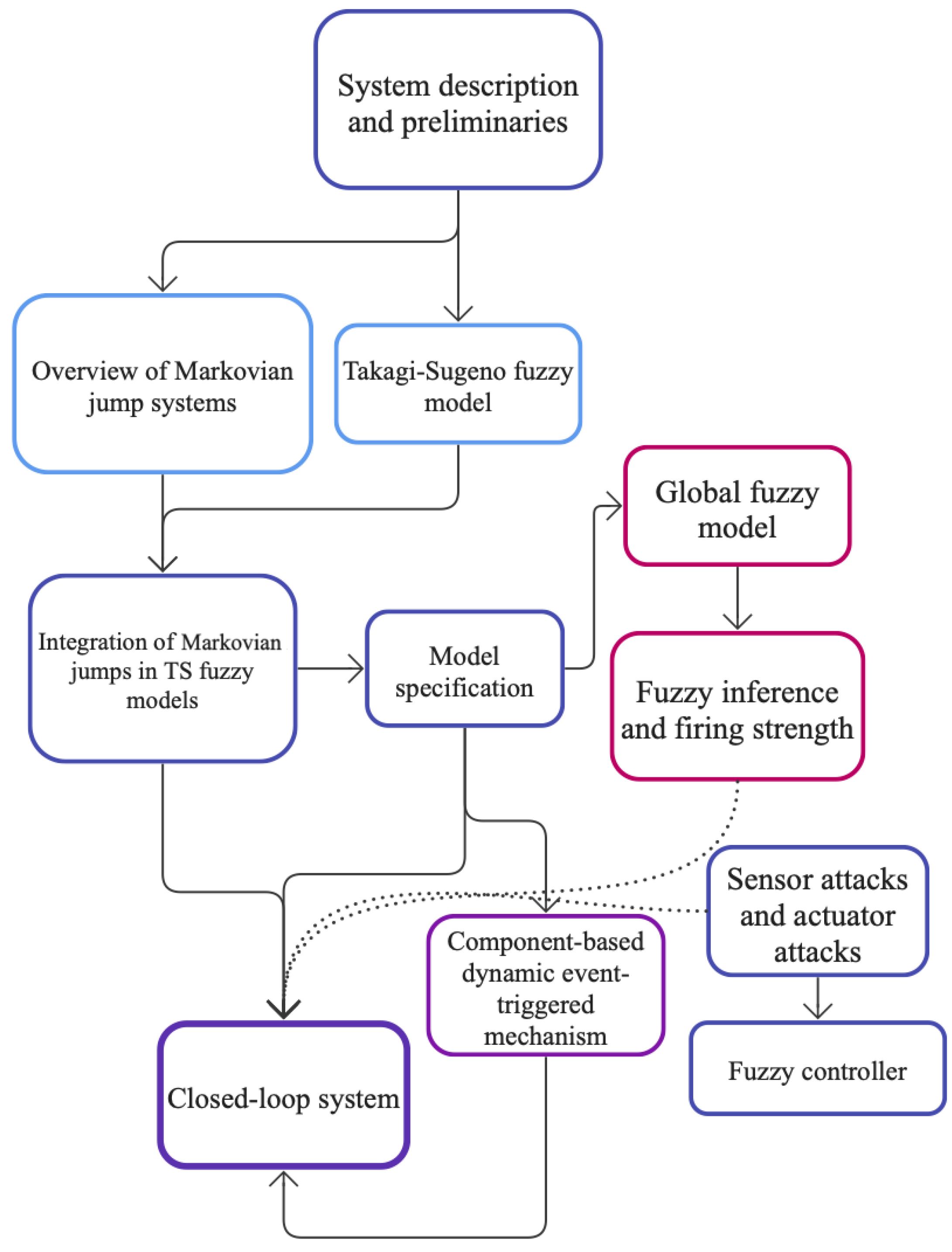
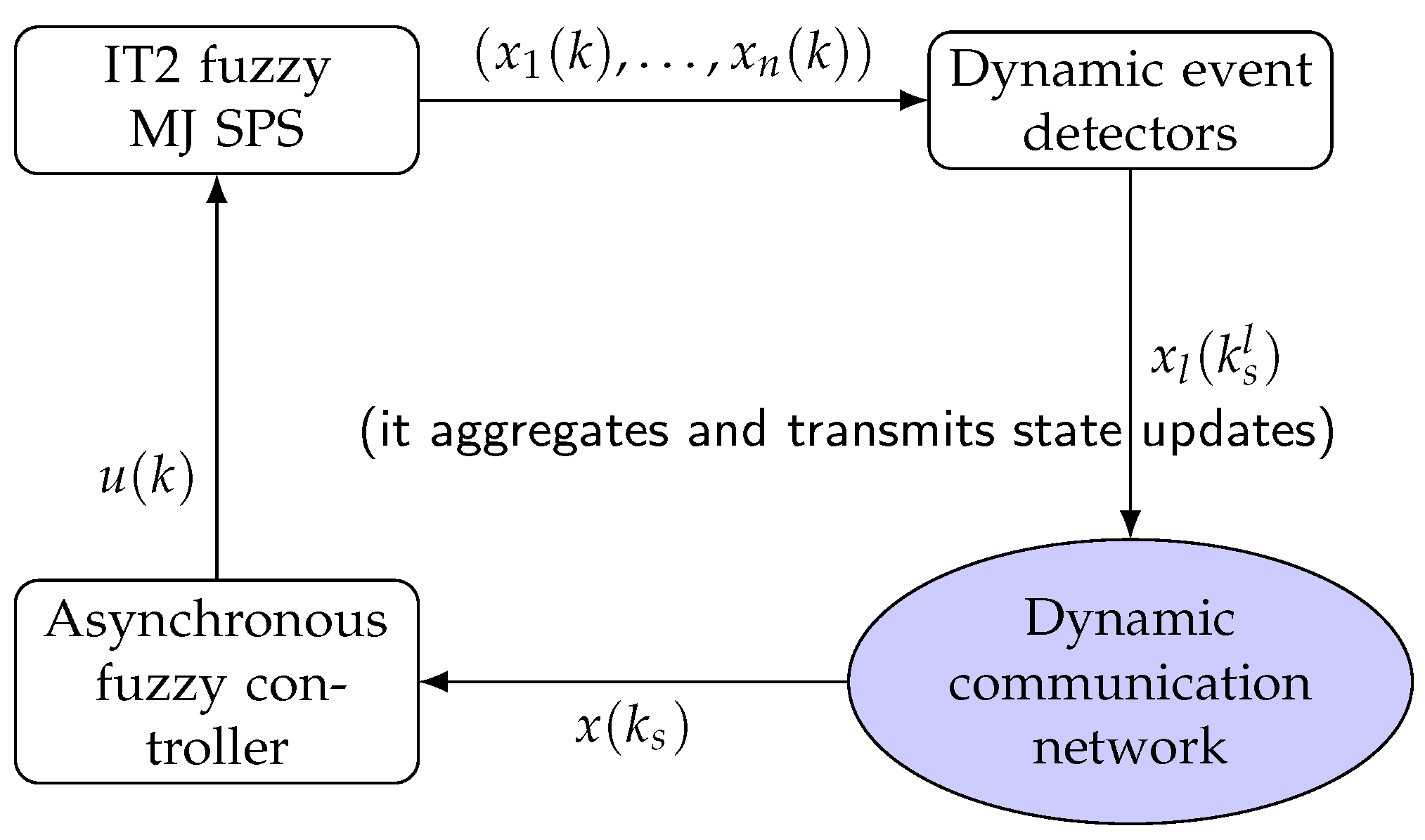

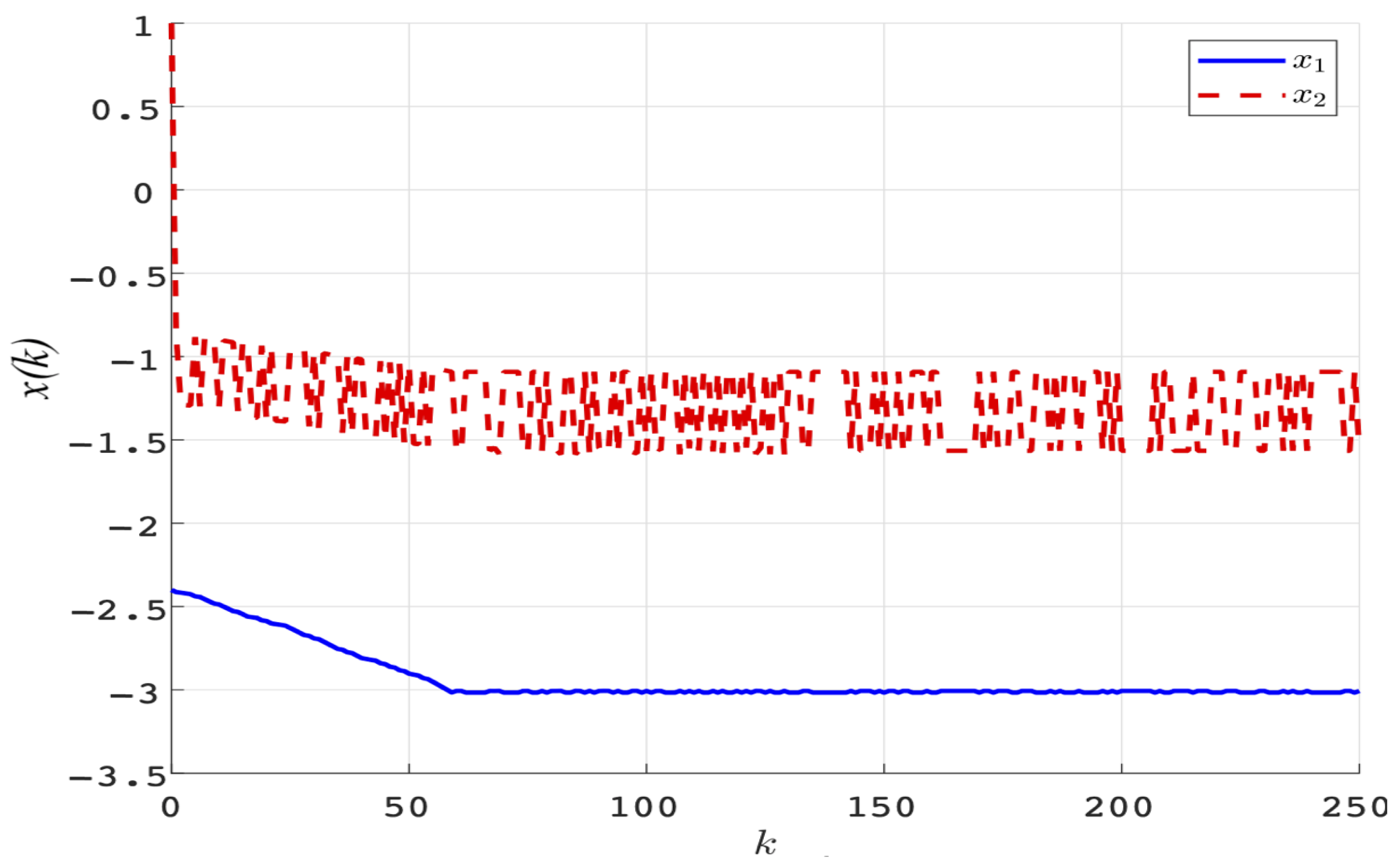

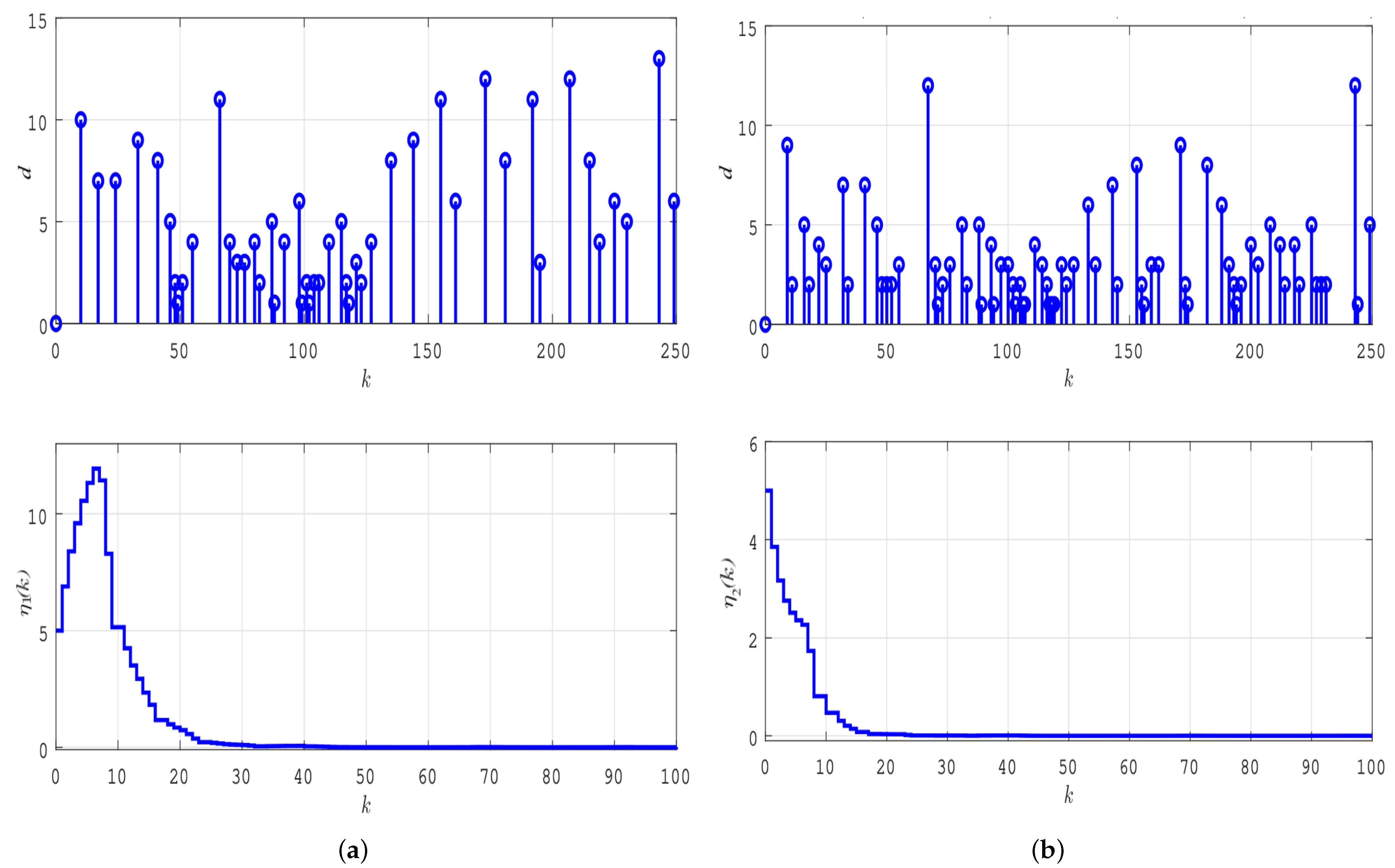
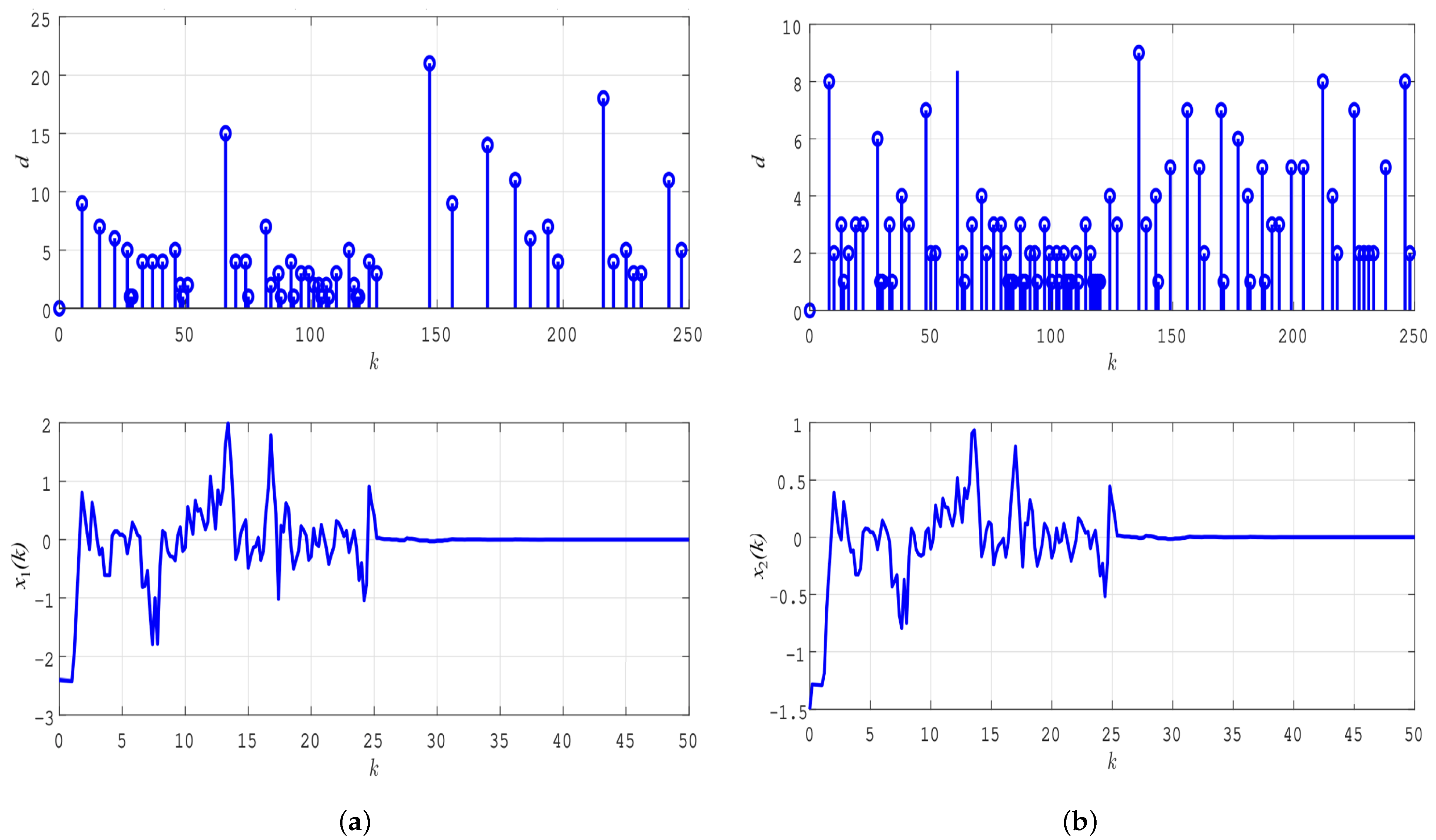
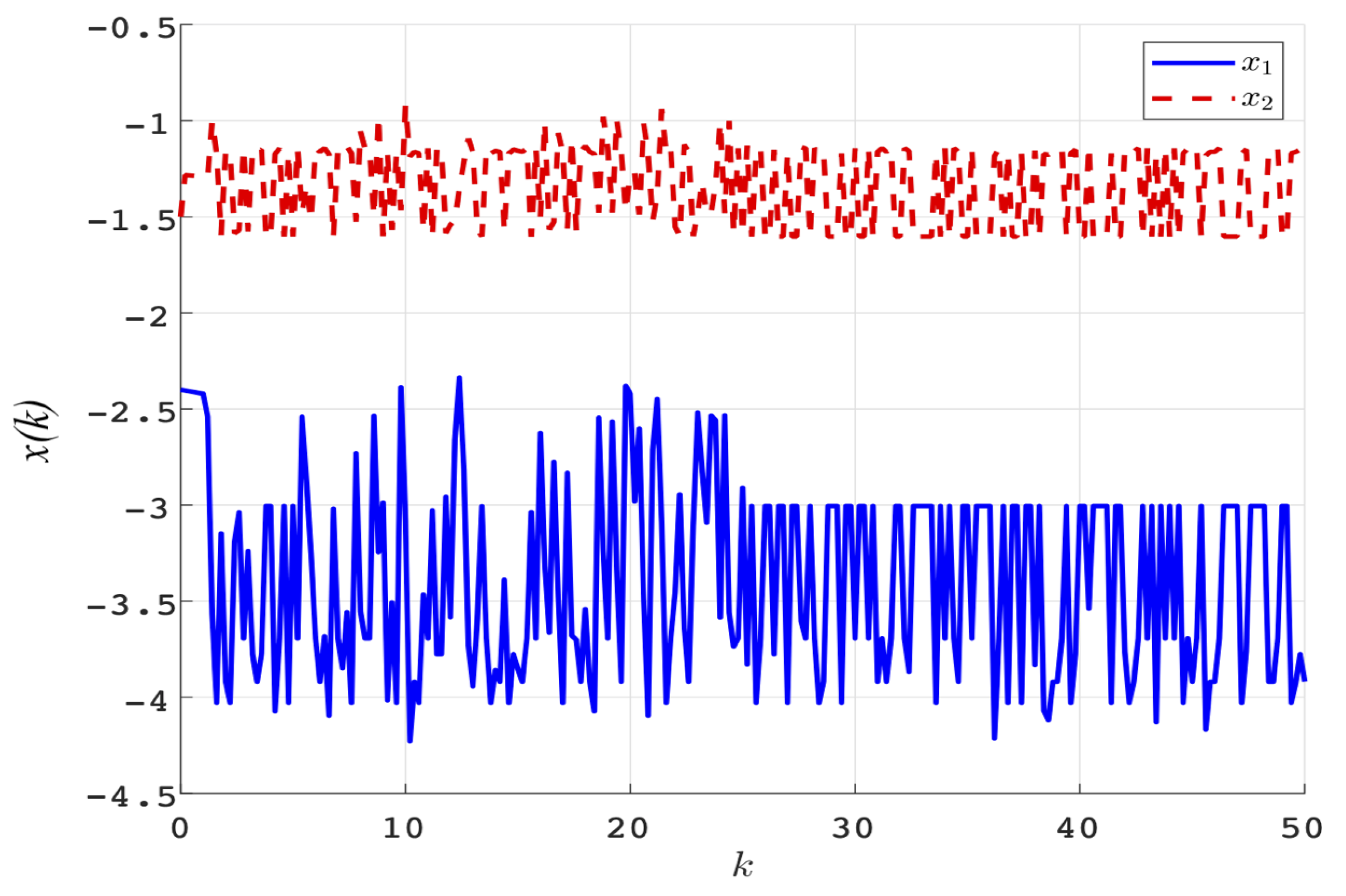
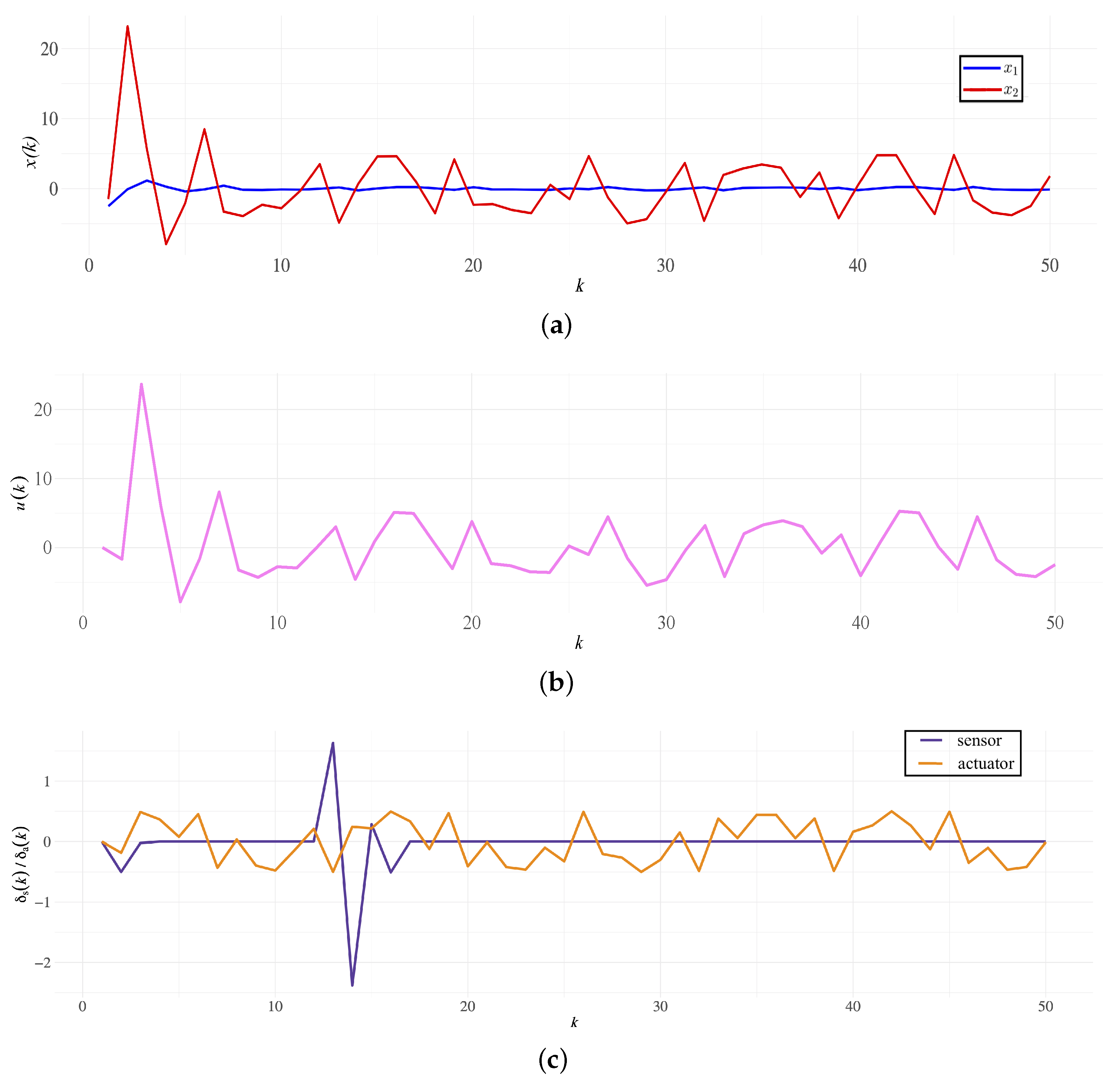
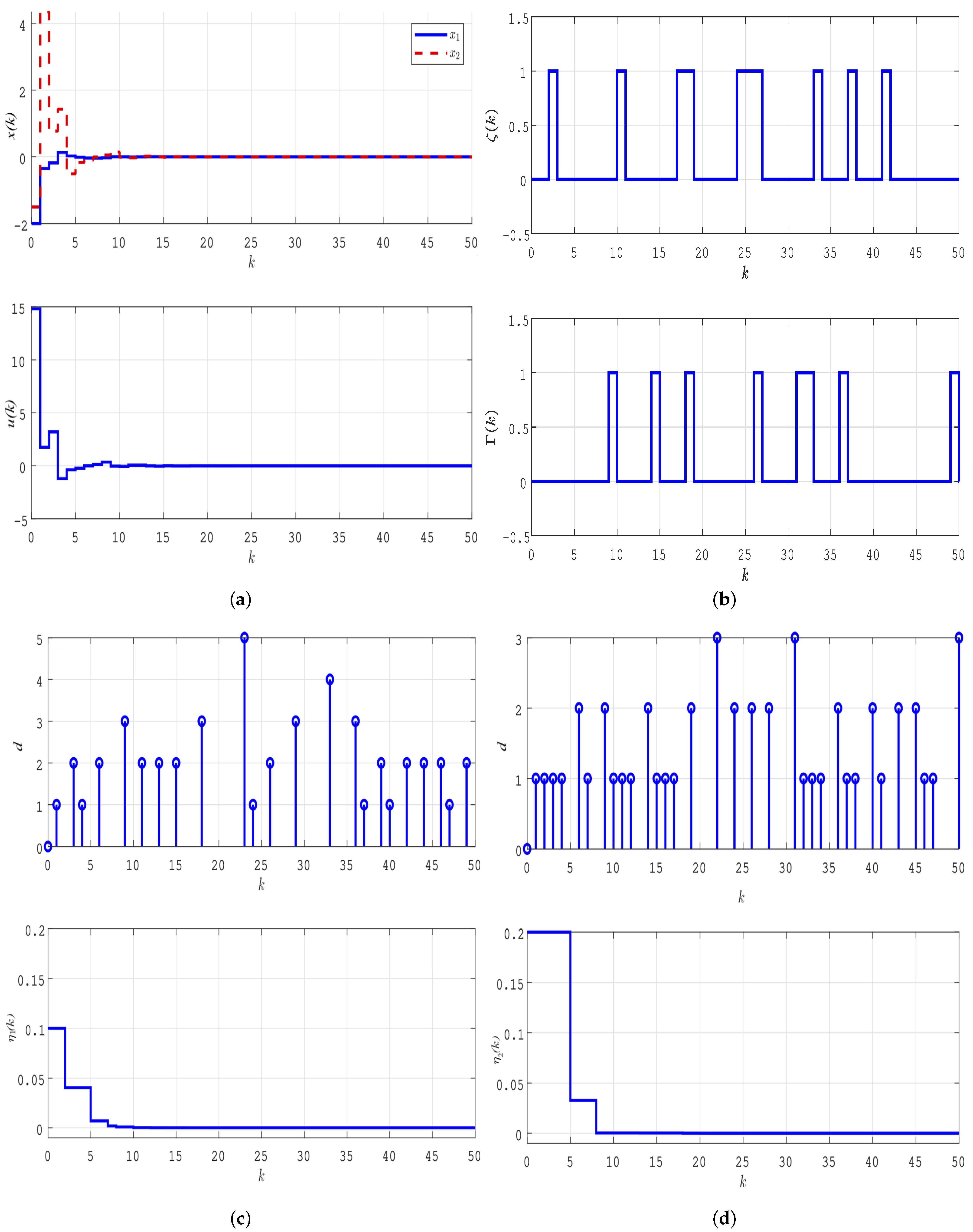
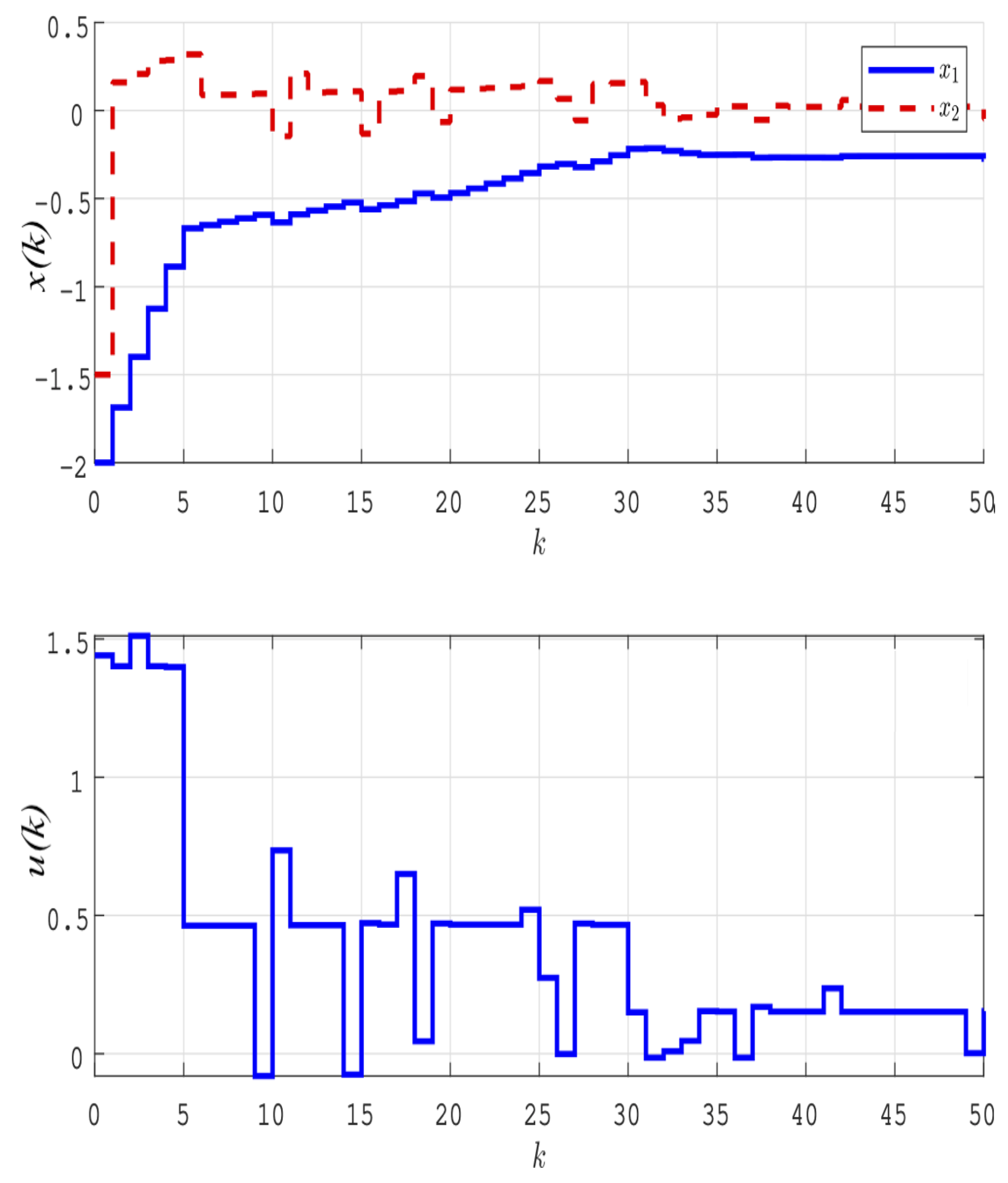
| Parameter | ||||
|---|---|---|---|---|
| Sensor 1 | 0.5 | 3 | 0.8 | 5 |
| Sensor 2 | 0.4 | 4 | 0.6 | 5 |
| Minimum Values | Maximum Values | |
|---|---|---|
| Gains | ||
| Number of triggering | 73 | 76 |
| Communication rate | 29.08% | 30.27% |
| Parameter | ||||
|---|---|---|---|---|
| Sensor 1 | 0.2 | 10 | 0.4 | 0.1 |
| Sensor 2 | 0.1 | 8 | 0.5 | 0.2 |
Disclaimer/Publisher’s Note: The statements, opinions and data contained in all publications are solely those of the individual author(s) and contributor(s) and not of MDPI and/or the editor(s). MDPI and/or the editor(s) disclaim responsibility for any injury to people or property resulting from any ideas, methods, instructions or products referred to in the content. |
© 2024 by the authors. Licensee MDPI, Basel, Switzerland. This article is an open access article distributed under the terms and conditions of the Creative Commons Attribution (CC BY) license (https://creativecommons.org/licenses/by/4.0/).
Share and Cite
Kchaou, M.; Castro, C.; Abbassi, R.; Leiva, V.; Jerbi, H. Security Control for a Fuzzy System under Dynamic Protocols and Cyber-Attacks with Engineering Applications. Mathematics 2024, 12, 2112. https://doi.org/10.3390/math12132112
Kchaou M, Castro C, Abbassi R, Leiva V, Jerbi H. Security Control for a Fuzzy System under Dynamic Protocols and Cyber-Attacks with Engineering Applications. Mathematics. 2024; 12(13):2112. https://doi.org/10.3390/math12132112
Chicago/Turabian StyleKchaou, Mourad, Cecilia Castro, Rabeh Abbassi, Víctor Leiva, and Houssem Jerbi. 2024. "Security Control for a Fuzzy System under Dynamic Protocols and Cyber-Attacks with Engineering Applications" Mathematics 12, no. 13: 2112. https://doi.org/10.3390/math12132112









